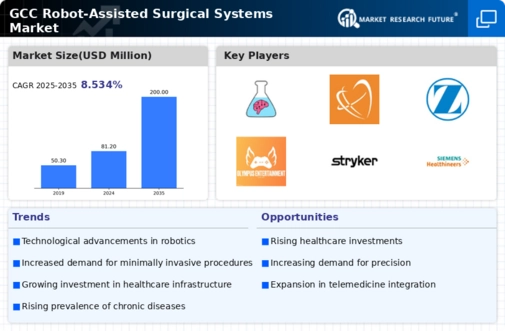Government Initiatives and Funding
Government initiatives aimed at enhancing healthcare infrastructure play a crucial role in the growth of the robot assisted-surgical-systems market. In the GCC, various governments are investing heavily in healthcare modernization, which includes the adoption of advanced surgical technologies. For instance, funding programs and incentives for hospitals to acquire robotic systems are becoming more common. This financial support not only facilitates the procurement of expensive robotic systems but also encourages research and development in surgical robotics. As a result, the market is expected to witness a surge in the adoption of these systems, potentially increasing the number of robotic surgeries performed annually.
Rising Prevalence of Chronic Diseases
The increasing prevalence of chronic diseases such as cancer, cardiovascular disorders, and obesity is driving the demand for advanced surgical solutions, including robotic systems. In the GCC region, the incidence of these conditions has been on the rise, leading to a greater need for effective surgical interventions. The robot assisted-surgical-systems market is likely to benefit from this trend, as robotic surgeries offer precision and improved outcomes for complex procedures. With an estimated 30% of the population in the GCC suffering from chronic diseases, the demand for robotic-assisted surgeries is expected to grow significantly, thereby enhancing the market's potential.
Technological Integration in Healthcare
The integration of cutting-edge technologies such as artificial intelligence (AI) and machine learning into surgical robotics is transforming the robot assisted-surgical-systems market. In the GCC, healthcare providers are increasingly adopting these technologies to enhance surgical precision and outcomes. AI-driven robotic systems can analyze vast amounts of data to assist surgeons in making informed decisions during procedures. This technological evolution not only improves the efficiency of surgeries but also reduces the likelihood of complications. As hospitals continue to embrace these innovations, the market for robotic-assisted surgeries is anticipated to expand, reflecting a shift towards more intelligent and automated surgical solutions.
Growing Awareness and Acceptance Among Surgeons
The growing awareness and acceptance of robotic-assisted surgeries among healthcare professionals is a significant driver in the robot assisted-surgical-systems market. Surgeons in the GCC are increasingly recognizing the benefits of robotic systems, including enhanced dexterity, improved visualization, and reduced fatigue during lengthy procedures. As training programs and workshops become more prevalent, the proficiency of surgeons in utilizing these systems is expected to increase. This acceptance is likely to lead to a higher adoption rate of robotic-assisted surgeries, thereby contributing to the overall growth of the market. The collaboration between manufacturers and medical institutions to provide comprehensive training further supports this trend.
Increasing Demand for Minimally Invasive Procedures
The rising preference for minimally invasive surgical techniques is a key driver in the robot-assisted surgical systems market. Patients are increasingly opting for procedures that promise reduced recovery times, less postoperative pain, and minimal scarring. This trend is evident in the GCC region, where healthcare providers are adapting to patient demands by integrating advanced robotic systems into their surgical offerings. The market for robotic-assisted surgeries is projected to grow at a CAGR of approximately 15% over the next five years, reflecting the shift towards these innovative surgical methods. As hospitals and surgical centers invest in robotic technologies, the overall efficiency and effectiveness of surgical procedures are likely to improve, further propelling the market forward.

















Leave a Comment